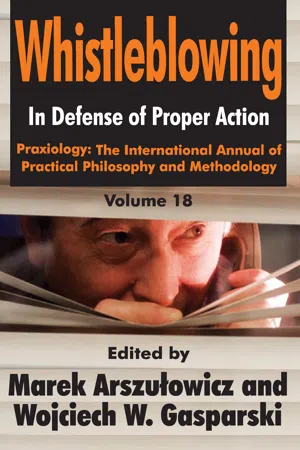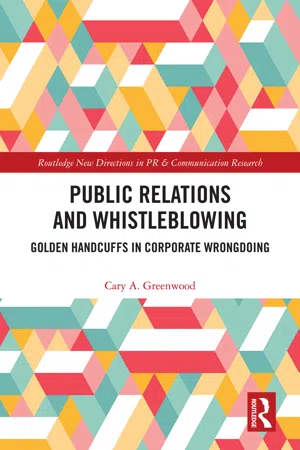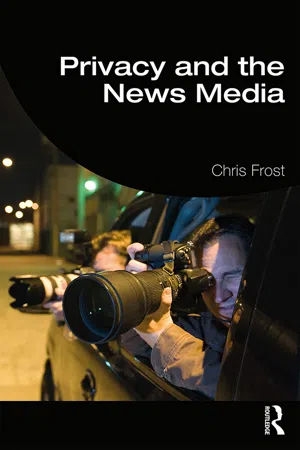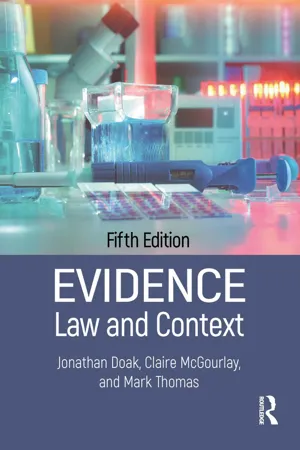Law
Public interest disclosure act
The Public Interest Disclosure Act is legislation that protects whistleblowers who report wrongdoing within an organization. It provides legal safeguards for individuals who disclose information about misconduct, corruption, or dangers to public health and safety. The act aims to encourage transparency and accountability while shielding whistleblowers from retaliation.
Written by Perlego with AI-assistance
6 Key excerpts on "Public interest disclosure act"
Learn about this page
Index pages curate the most relevant extracts from our library of academic textbooks. They’ve been created using an in-house natural language model (NLM), each adding context and meaning to key research topics.
- eBook - ePub
Whistleblowing
In Defense of Proper Action
- Wojciech W. Gasparski(Author)
- 2017(Publication Date)
- Routledge(Publisher)
The Law and Practice of Whistleblowing in the United Kingdom David Lewis Middlesex University, U.K.1. Introduction
The purpose of the U.K.’s Public interest disclosure act 1998 is “to protect individuals who make certain disclosures of information in the public interest.” It does so, primarily, by inserting a new Part IVA into the Employment Rights Act 1996 (henceforward ERA 1996).1 PIDA 1998 was the model for South Africa’s Protected Disclosures Act 2000 and has been regarded as an exemplary piece of legislation in debates in other countries, for example, the Netherlands, New Zealand and some Australian states.2 This chapter will outline the U.K. statutory provisions and will then consider recent research on how whistleblowing procedures operate in practice.2. What Types of Wrongdoing Can be Disclosed and by Whom?
Section 43B(1) of ERA 1996 defines a “qualifying disclosure” as one which a worker reasonably believes tends to show a matter falling into one or more of the following: (1) a criminal offense; (2) a failure to comply with any legal obligation; (3) a miscarriage of justice; (4) danger to the health and safety of any individual (i.e., not necessarily a worker); (5) damage to the environment; (6) the deliberate concealment of information tending to show any of the matters listed above. Apart from disclosures made to legal advisers, the U.K. provisions only apply to whistleblowers who act in good faith.Turning to specific exclusions, the U.K. legislation applies to Crown employment (but not the security services) in the same way as it applies to other workers, save where a certificate of exemption has been issued on grounds of national security.3 - eBook - ePub
Public Relations and Whistleblowing
Golden Handcuffs in Corporate Wrongdoing
- Cary A. Greenwood(Author)
- 2021(Publication Date)
- Routledge(Publisher)
Whistleblowing Law and Practice (Lewis, Bowers, Fodder, & Mitchell, 2017), Lewis (2018) notes that changes to Part IVA Employment Rights Act 1996 [by the Enterprise and Regulatory Reform Act 2013 (Ashton, 2015)] reflect the movement from the former common law standard of “good faith” to one of “public interest” as a criterion for “qualifying disclosure,” and also include more specific sanctions for retaliation against a whistleblower (Lewis, 2018, p. 165). In addition, courts have ruled on the nature of disclosure, causation for termination, and the definition of “worker” for purposes of “detriment or dismissal suffered after making a protected disclosure” (Lewis, 2018, p. 165). The PIDA includes specific provisions for whistleblowers who report externally under certain circumstances.The PIDA in particular protects workers engaged in external reporting, when the workers have reasonable belief that evidence would be destroyed or hidden when disclosures are made to employers; or when workers have reasonable belief that they would be subject to retaliations by employers when disclosures are made to the latter; or when the employers have not acted to investigate or address the wrongdoing.(Yeoh, 2013, p. 222)A more recent law, the UK Bribery Act 2010, encourages businesses to establish mechanisms for internal reporting to address corruption, but it does not offer any provisions for protection of whistleblowers or recommendation about the kind of mechanisms businesses need to implement (Yeoh, 2013).A recent court decision, Chesterton Global and another v. Nurmohamed, has clarified the term “in the public interest”(Court rules small groups can bring whistleblowing claims, 2017). Perhaps most importantly, the court decided that the public interest may involve relatively small groups. This case involved a real estate (estate) agent who alleged managers were deliberately underestimating the commissions of a group of approximately 100 agents in order to give the agents’ commissions to shareholders of the firm.The public interest test introduced to whistleblowing law in 2013 was intended to prevent workers using whistleblowing laws to make personal grievances about their contracts, and placed the onus on employees to prove their disclosure was made in the public interest…. The changes introduced in 2013 failed to define what “in the public interest” meant. - eBook - ePub
- Eric R. Boot(Author)
- 2019(Publication Date)
- Routledge(Publisher)
This chapter has undertaken to clarify what is generally regarded as the most fundamental condition for justified whistleblowing, namely that it be in the public interest. According to the civic account of the public interest defended here, the public interest consists of interests we share in our role as members of the community. Those interests were further identified as interests in conditions that render it possible for each of us to develop and strive to realize our own values, objectives, and life plans. Examples of such conditions include political accountability, human rights, and the rule of law. It follows from this understanding of the public interest, that an act of whistleblowing meets the public interest condition if and only if it is the case that the unauthorized disclosure of classified documents better serves the public interest than the alternative (i.e., continued secrecy). More specifically, an act of whistleblowing is justifiable if and only if the disclosure of the information did, on balance, more good than harm to the interest we share as members of the political community in those conditions that need to be in place if all members are to be able to pursue their own interests.In addition to the public interest condition, I have identified two procedural conditions: the exhaustion of legal alternatives (ultimum remedium ) and the minimization of harm. Finally, I have pointed out that these three conditions do not stand on an equal footing: the public interest condition is a threshold condition, indicating its greater importance with respect to the two procedural conditions. This distinction between the public interest condition and the procedural conditions will allow us to distinguish between varying degrees of either wrongful or justifiable whistleblowing.Having provided a conceptual clarification of the public interest as well as an exposition of the conditions for justified whistleblowing, it remains for us to see how both of these can be applied to actual cases of unauthorized disclosures. This task will be undertaken in Chapter 5 , which will present a public interest defense of whistleblowing. First, however, the next chapter will discuss the most commonly proposed defense for justified cases of whistleblowing, namely the defense based on individual rights (typically the right to freedom of expression).Notes
1 This chapter draws from Boot, Eric R. 2019. The Feasibility of a Public Interest Defense for Whistleblowing. Law and Philosophy . Forthcoming. It also draws from Boot, Eric R. 2017. Classified Public Whistleblowing: how to Justify a pro tanto Wrong. Social Theory and Practice - eBook - ePub
- Chris Frost(Author)
- 2019(Publication Date)
- Routledge(Publisher)
www.ipso.co.uk/editors-code-of-practice/#ThePublicInterest accessed Mar. 2019). Editors would need to justify such a broad defence by demonstrating “that they reasonably believed publication – or journalistic activity taken with a view to publication – would both serve, and be proportionate to, the public, the public interest and explain how they reached that decision at that time” (ibid.). However, Leveson goes on to recognise that these public interest powers must be used consistently with other democratic powers including the law and the personal and public rights of others.The IPSO code of practice as amended in 2016 also identifies the public interest as including:- Detecting or exposing crime, or the threat of crime, or serious impropriety.
- Protecting public health or safety.
- Protecting the public from being misled by an action or statement of an individual or organisation.
- Disclosing a person or organisation’s failure or likely failure to comply with any obligation to which they are subject.
- Disclosing a miscarriage of justice.
- Raising or contributing to a matter of public debate, including serious cases of impropriety, unethical conduct or incompetence concerning the public.
- Disclosing concealment, or likely concealment, of any of the above. (Ibid.)
Ofcom, in its broadcasting code, outlines a range of circumstances in which privacy can only be invaded if warranted. This has a particular meaning in that broadcasters should be able to demonstrate why intrusion in that instance is warranted. One of the reasons could be that the coverage is in the public interest and that the public interest outweighs the right to privacy. Ofcom gives examples of public interest as: “revealing or detecting crime, protecting public health or safety, exposing misleading claims made by individuals or organisations or disclosing incompetence that affects the public” (www.ofcom.org.uk/tv-radio-and-on-demand/broadcast-codes/broadcast-code/section-eight-privacy - eBook - ePub
- Charanjit Singh, Mohamed Ramjohn(Authors)
- 2016(Publication Date)
- Routledge(Publisher)
Although as case law demonstrates government officials usually make most claims for PII; however, private individuals are also entitled to claim it (see D v NSPCC [1978] AC 171 or R v Reading Justices, ex p Berkshire County Council (1996) 1 Cr App R 239). The primary justification for establishing ‘public interest immunity’ is based on the policy that the public interest in protecting certain pieces of information or documents outweighs the narrower concept of justice being accorded to a private individual in having all the relevant evidence available to them for presentation to the court. In Rogers v Home Secretary [1973] AC 388 Lord Pearson stated: Judgment ‘The court has to balance the detriment to the public interest on the administrative or executive side which would result from the disclosure of the document against the detriment to the public interest on the judicial side resulting from non-disclosure of a document which is relevant to an issue in legal proceedings.’ Section 21 of the Criminal Procedure and Investigations Act 1996 (CPIA) governs the basis of public interest immunity in criminal cases. It provides: Section ‘(1) Where this Part applies as regards things failing to be done after the relevant time in relation to an alleged offence, the rules of common law which (a) were effective immediately before the appointed day, and (b) relate to the disclosure of material by the prosecutor, do not apply as regards things failing to be done after that time in relation to the alleged offence … (2) Subsection (1) does not affect the rules of common law as to whether disclosure is in the public interest.’ The CPIA 1996 normally requires full disclosure by the prosecution unless the common law rules apply. It should be noted that the Criminal Justice Act 2003, reference to which will be made in this chapter as and when necessary, has amended the 1996 Act - eBook - ePub
- Jonathan Doak, Claire Mcgourlay, Mark Thomas(Authors)
- 2018(Publication Date)
- Routledge(Publisher)
Ward . At present, the Criminal Procedure and Investigations Act (CPIA) 1996 is just one of a number of sources used in criminal litigation governing the operation of PII; other tools include the Criminal Procedure Rules (Crim PR) 2015, the Attorney General’s Guidelines on Disclosure 2013, and the Crown Prosecution Service’s Disclosure Manual 2004.These developments essentially mean that Crown privilege is no more and the preferred phrase now is ‘public interest immunity’, which refers to matters excluded on grounds of public policy.17In any event, ‘Crown privilege’ was an inaccurate phrase, which differed from the contemporary operation of PII in a number of ways:- (i) Under Crown privilege it was often not the Crown that initiated the proceedings but, rather, the Crown simply intervened to claim the ‘privilege’.
- (ii) An objection on the grounds of privilege could only have been made in relation to the production or inspection of the relevant document, whereas an objection on the grounds of public interest immunity is not restricted to the inspection of a document, but may also be made in relation to the disclosure of that document.18
- (iii) Crown privilege implied that the matters at stake were of high national concern or great issues of state. In fact, Crown privilege often applied to neither of these. Durston affirms this, arguing that the reality was that it would normally concern ‘much more mundane matters, such as the identity of a police informer or the efficient operation of a public service’.19 Case law further demonstrates this misnomer with such authorities as D v NSPCC ,20





